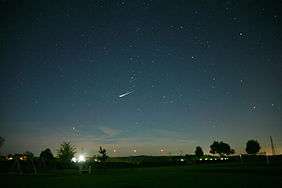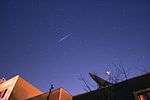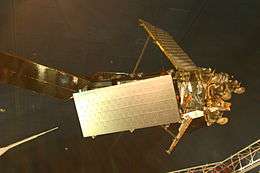Satellite flare
| |||
| |||
Satellite flare, also known as satellite glint, is the phenomenon caused by the reflective surfaces on satellites (such as antennas, SAR or solar panels) reflecting sunlight directly onto the Earth below and appearing as a brief, bright "flare".
The Iridium constellation with 66 active telecommunication satellites in low Earth orbit are known to cause the brightest flares of all orbiting satellites.
Controlled satellites
Time and place of the satellite's flare can be predicted only when the satellite is controlled, and its orientation in space is known. In this case it is possible to predict the exact time of the flare, its place in the sky, the brightness and duration.
Iridium flares
Most Iridium satellites are still controlled, so their flares can be predicted. The Iridium communication satellites have a peculiar shape with three polished door-sized antennas, 120° apart and at 40° angles with the main bus. The forward antenna faces the direction the satellite is travelling. Occasionally, an antenna reflects sunlight directly down at Earth, creating a predictable and quickly moving illuminated spot on the surface below of about 10 km (6.2 mi) diameter. To an observer this looks like a bright flash, or flare in the sky, with a duration of a few seconds.
Ranging up to −8 magnitude (rarely to a brilliant −9.5), some of the flares are so bright that they can be seen in the daytime; but they are most impressive at night. This flashing has caused some annoyance to astronomers, as the flares occasionally disturb observations.
As the Iridium constellation consists of 66 working satellites, Iridium flares are visible quite often (2–4 times per night). Flares of brightness −5 magnitude occur 3–4 times per week; −8 magnitude may be visible 3–5 times per month for stationary observers.
Flares may also occur from solar panels, but they are not as bright (up to −3.5 magnitude). Such flares last about twice as long as those from the main mission antennas (MMA), because the so-called "mirror angle" for the solar panels is twice that for the MMAs. There are also rare cases of flares from MMAs and solar panels, or two MMAs (front and either right or left) of one satellite in a single pass.
The flares can be bright enough to be seen at night in big cities where light pollution usually prevents most stellar observation. When not flaring, the satellites are often visible crossing the night sky at a typical magnitude of 6, similar to a dim star.
Non-Iridium flares
There are many controlled satellites in addition to Iridium satellites, which can also flare, but most flares of these satellites do not exceed magnitude −2, therefore, they are often overlooked.
MetOp-A and B, however, can produce predictable flares up to −5 mag. Four COSMO-SkyMed satellites can produce flares up to −4 mag., but their peculiarity is that they last much longer than the Iridium flares.
Most flares from other satellites are almost indistinguishable from dim Iridium flares.
Uncontrolled satellites
When the satellite's orientation goes out of control, it becomes possible to predict only a trajectory of its pass, at any point of which it can flare up. These satellites are also described as "tumbling". This category includes a lot of rotating rocket bodies, some failed Iridium satellites, ALOS satellite (which can produce flashes up to −10 mag), etc. The most important and valuable information about tumbling satellites is a period of flashes. It can vary from 0.3–0.5 seconds (rapidly rotating objects) to a minute or more (slowly rotating objects). Other important characteristics are the amplitude of changes in brightness and period of repetition of these changes.
Observation
While satellites may be seen by chance, there are websites and smartphone apps which provide location specific information as to when and where in the sky a satellite flare may be seen (for controlled satellites), or trajectory of a tumbling satellite's pass (for uncontrolled satellites) in the sky.[1][2][3][4]
Gallery
 A 30-second exposure of a flare produced by an Iridium 84 satellite.
A 30-second exposure of a flare produced by an Iridium 84 satellite. Iridium Flare in the direction of Venus.
Iridium Flare in the direction of Venus. Iridium flare on a moonlit night in Võru County, Estonia.
Iridium flare on a moonlit night in Võru County, Estonia. Video of an Iridium flare in the constellation Cassiopeia
Video of an Iridium flare in the constellation Cassiopeia
See also
References
- ↑ http://www.heavens-above.com - predicts flares from antennas of Iridium satellites only.
- ↑ http://www.calsky.com - predicts flares also from solar panels of Iridium satellites, and flares from some non-Iridium satellites. Also predicts the passes of tumbling satellites.
- ↑ https://play.google.com/store/apps/details?id=com.runar.issdetector&hl=en - shows Iridium flares according to Heavens-Above.
- ↑ "Satellite Observer". windowsphone.com. 15 January 2014.
External links
- sourceforge
.net – PreviSat software for Iridium flares prediction/projects /previsat / - www
.heavens-above – schedule of upcoming Iridium flares.com /IridiumFlares .aspx - iridiumflares
.sourceforge – IridiumFlares prediction software (Java application).net - satobs
.org – "Catch a Flaring Iridium" at Visual Satellite Observer/iridium .html - www
.fifthstarlabs – SkyGuide.com -
 Media related to Iridium flares at Wikimedia Commons - Iridium flares in Wikimedia Commons
Media related to Iridium flares at Wikimedia Commons - Iridium flares in Wikimedia Commons



